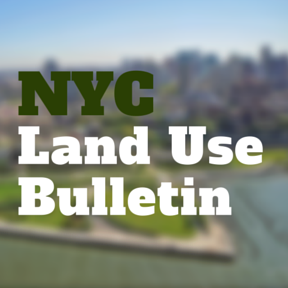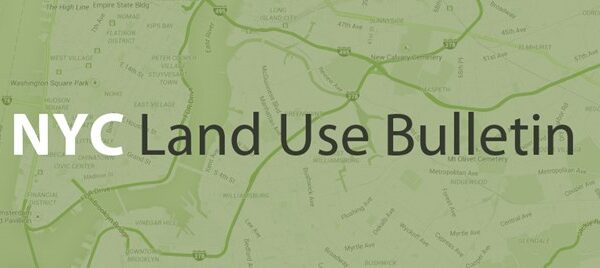
NYC Land Use Bulletin- City Planning Begins Public Review for Mandatory Inclusionary Housing and Two Major Zoning Initiatives
On Monday, September 21, 2015, the City Planning Commission kicked off the formal public review process for three major City Planning zoning initiatives designed to advance the Mayor’s Housing New York Plan to produce and preserve 200,000 units of affordable housing over the next 10 years.
Two of these initiatives are citywide text amendments — for Mandatory Inclusionary Housing (MIH) and Zoning for Quality and Affordability (ZQA). The third is the East New York Rezoning which is the first of about a dozen neighborhoods under study for rezoning and infrastructure investments.
Read City Planning’s press release for the text amendments here: City Planning Begins Public Review for Two Major Zoning Text Changes Related to Housing New York
Capalino has insight on these initiatives and advises our clients on the implications for existing and proposed projects. For further information, please contact our team: Richard Barth, Senior Advisor for Land Use + Housing Strategies, at Richard@nullcapalino.com, or Claire Altman, Director of Affordable + Supportive Housing Development Services, at Claire@nullcapalino.com.
Mandatory Inclusionary Housing (MIH)
The new Mandatory Inclusionary Housing program represents a significant departure from the current inclusionary housing program, which incentivizes affordable housing by offering floor area bonuses. This new mandatory program is intended to work together with City housing subsidies, the ZQA text amendment, and new rules for 421a tax abatements.
The key components of the new mandatory program include:
Applicability
- MIH would only be applicable for development in areas to be rezoned in the future and in conjunction with private land use applications for zoning changes and other discretionary special permit applications.
- Where made applicable, MIH would apply to developments, enlargements or conversions.
- MIH would not apply to developments of 10 units or less (or 12,500 sf or less).
- MIH to be applied as a condition of granting special permits outside of designated MIH areas for use and bulk modifications that facilitate the creation of “a significant number of additional dwelling units.” CPC could reduce, modify or waive these requirements if project facilitates significant public infrastructure investments that address needs not generated by the development.
- The existing incentive-based, voluntary inclusionary program would continue to apply where applicable.
Affordability Options – Affordable Units to be permanently affordable
- Two primary affordable options:
- 25% of residential floor area affordable to households with incomes averaging 60% of AMI (e.g. $46,620 for a family of three). No units above 130% of AMI allowed.
- 30% of residential floor area affordable for households with incomes averaging 80% of AMI (e.g. $62,150 for a family of three). No units above 130% of AMI allowed.
- A third option (workforce option), applicable in certain markets and only outside Manhattan Community Boards 1-8, requires 30% of residential floor area for housing moderate income households (average AMI of 120% – none to exceed 130% of AMI) but no direct public subsidies allowed.
Location of Affordable Units
- Affordable units would be allowed in:
- Same building as market rate units, but with a common door and distributed on at least 50% of floors. Distribution requirements would not apply for affordable senior and supportive housing. Other exceptions apply.
- Separate building on the same zoning lot.
- Separate zoning lot (within same CD or one half a mile of development site.)
Other Rules
- MIH establishes unit bedroom mixes consistent with those for the existing inclusionary program, but excludes senior housing. Minimum unit sizes would also apply.
- Payment in Lieu Option: available to developments of between 10 and 25 units (12,500 sf to 25,000 sf of residential development). Fee to be established through HPD guidelines.
- New BSA Special Permit to reduce the amount of affordable housing required or modify affordability requirements for developments made infeasible by MIH. Only available where MIH, and not other conditions, are the source of the hardship.
- A number of other program and administrative provisions apply.
Zoning for Quality and Affordability (ZQA)
This citywide text amendment is a set of targeted zoning changes to support the creation of affordable and senior housing throughout the city and to promote better quality residential buildings. For a summary of the proposal, read our previous Land Use Bulletin: City Planning Releases Draft Zoning Text for Zoning for Quality and Affordability
The three categories of the proposal include:
- Changes to make it easier to provide the range of affordable senior housing and senior and long-term care facilities needed to meet the needs of this growing segment of the City’s population.
- Facilitating Inclusionary Housing buildings that provide mixed-income housing to construct high quality buildings by adjusting buildings heights and other rules to better accommodate the floor area allowed by the zoning.
- Reduced Parking Requirements for Affordable and Senior Housing, with elimination of parking for these developments within a proposed transit zone.
The Notice of Completion for the draft EIS for these changes, which includes a detailed description of the changes, can be found at http://www.nyc.gov/html/dcp/pdf/env_review/zoning-qa/noc_deis.pdf
East New York Rezoning
As part of the Mayor’s housing plan, the City committed to advancing comprehensive neighborhood plans to promote new residential development with significant amounts of permanently affordable housing coupled with infrastructure and other investments to serve the neighborhoods.
The East New York rezoning, which covers approximately 190 blocks, is the first neighborhood rezoning to be certified for public review.
This rezoning incorporates the new MIH provisions, and calls for zoning changes along Atlantic Avenue to facilitate 12- to 14-story residential buildings, and increased densities along Pitkein and Liberty avenues, and Fulton Street.
The draft EIS Notice of Completion, which contains a detailed description of the plan, can be found here: http://www.nyc.gov/html/dcp/pdf/env_review/east-new-york/noc_deis.pdf
Public Review Process + Next Steps
The Public Review Process for all three initiatives started September 21, 2015.
After review by the Community Boards, Borough Presidents and Borough Boards, the City Planning Commission will likely begin its public hearing review process as follows:
- Zoning Text Initiatives – December 2015
- East New York Rezoning – January 2016
- City Council review could begin in February or March 2016.
Where can I get more information?
Visit Department of City Planning’s website here: http://www.nyc.gov/html/dcp/html/housing/mandatory-inclusionary-housing-summary.shtml
These three zoning proposals will greatly influence the shape of the city and development in the years ahead. Capalino will continue to monitor these proposals and update you on how these changes may affect your developments and projects.
Please contact our team of experts for more details and further information.
Claire Altman
Executive Vice President of Affordable Housing + Community Development
Claire@nullcapalino.com
Richard Barth
Executive Vice President of Housing + Real Estate Strategies
Richard@nullcapalino.com
Christopher Collins
Executive Vice President of the Land Use Planning + Zoning Group
Christopher@nullcapalino.com
Learn More about our Real Estate Services
 Land Use Planning + Zoning
Land Use Planning + Zoning
We specialize in helping our clients secure City and State zoning and land use approvals.
 Housing + Real Estate
Housing + Real Estate
We identify and evaluate sites, housing and development opportunities, and craft creative solutions to address physical, regulatory, and other constraints.
Sign up for our weekly newsletter here to keep up with the latest news in New York.


